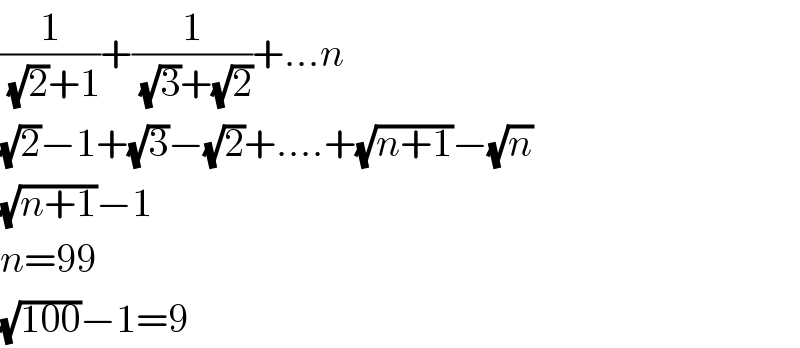
Question and Answers Forum
Question Number 121989 by mlj5 last updated on 13/Nov/20

Answered by Ar Brandon last updated on 13/Nov/20
![S_n =Σ_(k=1) ^n (1/( (√(k+1))+(√k)))=Σ_(k=1) ^n (((√(k+1))−(√k))/1) =Σ_(k=1) ^n [(√(k+1))−(√k)]=((√2)−(√1))+((√3)−(√2))+∙∙∙ +((√n)−(√(n−1)))+((√(n+1))−(√n)) Par te^� le^� scopage nous avons −(√1)+(√(n+1)) (√(n+1))−1≤9 ⇒ (√(n+1))≤10 ⇒n+1≤100 ⇒ n ≤ 99 D′ou^� le plus grand entier est n=99](Q121990.png)
Answered by Dwaipayan Shikari last updated on 13/Nov/20

| ||
Question and Answers Forum | ||
Question Number 121989 by mlj5 last updated on 13/Nov/20 | ||
 | ||
Answered by Ar Brandon last updated on 13/Nov/20 | ||
![S_n =Σ_(k=1) ^n (1/( (√(k+1))+(√k)))=Σ_(k=1) ^n (((√(k+1))−(√k))/1) =Σ_(k=1) ^n [(√(k+1))−(√k)]=((√2)−(√1))+((√3)−(√2))+∙∙∙ +((√n)−(√(n−1)))+((√(n+1))−(√n)) Par te^� le^� scopage nous avons −(√1)+(√(n+1)) (√(n+1))−1≤9 ⇒ (√(n+1))≤10 ⇒n+1≤100 ⇒ n ≤ 99 D′ou^� le plus grand entier est n=99](Q121990.png) | ||
| ||
Answered by Dwaipayan Shikari last updated on 13/Nov/20 | ||
 | ||
| ||